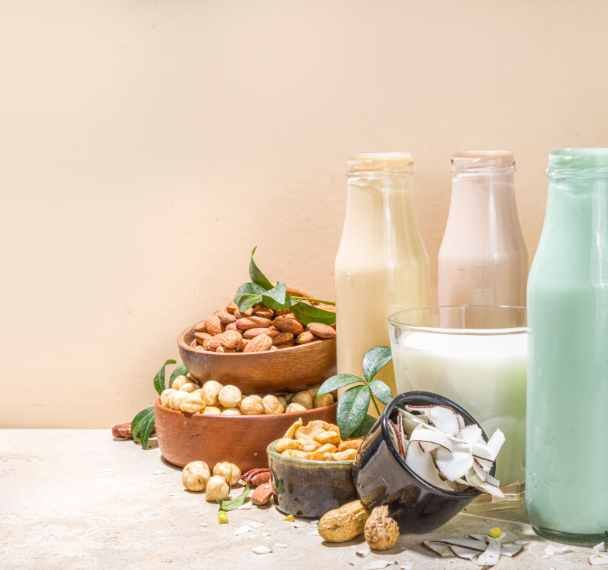How Fermentation Elevates the Flavours of Food & Beverage Products?
Sep 26, 2023
Introduction
Fermented foods are much more common than people realise. Many of us consume them on a daily basis, often without being aware of how they are made or the fact that they are produced using yeast, bacteria or mould.
Some examples of fermented foods include the classics bread, beer, wine, cheese, yoghurt, but also soy sauce, salami, coffee, and chocolate!
Fermentation has been used for centuries for its preserving properties. However, it is important to note that fermentation also offers incredible health benefits, as well as enhancing flavour and texture.
In this blog post, we will delve into the mechanisms of fermentation and explore how these microorganisms produce a wide range of unique and intriguing flavour compounds that can elevate the flavour quality of your products.
Microorganisms responsible for fermentation

Fermented foods and beverages are products that have been transformed by microorganisms, such as bacteria, yeast, and mould, using enzymes.
Microorganisms are found everywhere: in our gut, on our skin, in the air, on animals, plants, materials, and surfaces surrounding us. The majority of them are harmless, and some provide great benefits to us.
Only a small number of microorganisms are capable of causing diseases, such as Salmonella and E. coli.
Similarly, the microorganisms present in fermented foods and beverages are safe and contribute to creating an inhospitable environment that prevents the growth of disease-causing microorganisms.
However, it is crucial to respect proper food health and safety procedures. This ensures that the food is preserved effectively.
There are various types of microorganisms that contribute to the distinct flavours of fermented food and beverages.
Each type of microorganism has an optimal range for factors such as temperature, pH, and oxygen levels, as well as limits beyond which the microbe cannot survive. Let's explore a few examples.
Bacteria
Lactic acid bacteria (LAB)
LAB can be found in the milk of mammals as well as on the skins of fruits, vegetables, and humans. These bacteria utilise enzymes to break down sugars, whether in the form of carbohydrates or simple sugars, resulting in the production of lactic acid.
When LAB sub-species only convert sugar into lactic acid, they are classified as homofermentative. However, when they can produce other by-products, such as alcohol, carbon dioxide, and acetic acid, on top of lactic acid, they are classified as heterofermentative.
In the case of Cheddar and Parmigiano Reggiano cheeses, some sub-species can even break down proteins into amino acids, resulting in deep savoury flavours.
LAB are capable of tolerating low pH levels, high salt content, and can survive without the presence of oxygen (anaerobic conditions).
Lacto-fermented products have a distinct mellow acidity, some fruitiness and umami notes. These products include sour pickles, sauerkraut, rye breads, sourdough bread, yoghurt, and sour beers. LAB also plays a lesser role in the production of wine, cheese, and miso.
Acetic acid bacteria (AAB)
AAB are commonly found on the surface of many foods. They produce a sharp sourness by converting alcohol into acetic acid.
This is why they are often utilised alongside yeast, which converts sugar into alcohol.
They can tolerate low pH levels but need oxygen to survive (aerobic conditions). Fermented products using AAB include vinegar and kombucha.
Fungi
Saccharomyces cerevisiae
This particular yeast has the remarkable capability to transform various sugars, whether they are in the complex form of carbohydrates or simple sugars, into carbon dioxide and ethanol.
Yeast can survive with or without oxygen, but it's important to note that alcoholic fermentation is an anaerobic process. Yeast cells are not able to survive temperatures above 60 degrees.
Different Saccharomyces cerevisiae sub-species are used across applications as each of them will give specific flavour profile and alcohol levels to the finished product. For example, Saccharomyces cerevisiae used for wine tend to produce more alcohol and aromatic flavours than bread yeasts.
Fermented products using Saccharomyces cerevisiae include bread, beer and wine.
Moulds used in cheese making
Moulds are essential for creating the various types of cheeses we are familiar with. Each cheese requires a specific type of mould culture.
For instance, blue cheeses like Roquefort, Gorgonzola, and Stilton are made using Penicillium Roqueforti. On the other hand, Penicillium candidum is responsible for the distinctive white mould found in camembert and brie, while Brevibacterium Linens is used to make orange-coloured cheeses such as Brick, Limburger, and Muenster.
Aspergillus oryzae
Aspergillus oryzae is a mould, also known as kōji mould, that secretes enzymes such as protease, amylase, and lipase. These enzymes break down proteins, starches, and fats, resulting in deep savoury and earthy flavours.
This mould thrives in a warm and humid environment, ideally at around 30 degrees with 70% humidity. However, temperatures above 42 degrees will kill it.
Aspergillus oryzae is particularly prominent in the production of various traditional Asian foods, often used in conjunction with soybeans or rice, such as sake, miso, and soy sauce.
Types of fermentations

There are two main types of fermentation:
Wild fermentation
Wild fermentation relies on microorganisms that are naturally present in the environment, and it is used in the production of sauerkraut, kimchi, sourdough starter/bread, coffee, chocolate, and vanilla. This method is the oldest and most traditional form of fermentation.
In the previous blog series we explored how the cacao process, among fermentation have an impact on the chocolate flavour profile
Inoculated fermentation
Inoculated fermentation is a process that intentionally introduces specific cultures into a very controlled environment. This method is commonly employed in the production of various products such as wine, beer, cheese, and bread.
Some fermentations involve the sequential growth of different microorganisms. Each type of microorganism thrives under specific conditions, changing the environment to support the next group of microorganisms. Together, they transform the product.
For instance, the fermentation of chocolate begins with yeast, which is responsible for alcoholic fermentation. This occurs due to the sweet white mucilage that surrounds each cacao bean. As the yeast growth decreases, lactic acid bacteria take over, followed by acetic acid bacteria.
Aroma compounds created through fermentation
Microorganisms have the capacity to generate a wide variety of aroma compounds in fermented products.
Some compounds act as flavour precursors in the production of additional flavours, such as through lipid oxidation or Maillard reactions.
This is particularly noticeable in the fermentation process of coffee and chocolate, where Maillard reactions occur during the roasting of coffee/cacao beans, resulting in their distinct nutty and roasted characteristics.
Here are a few examples of flavours developed during fermentation:
Esters
Esters play a crucial role in the flavours of alcoholic beverages such as beer and wine, as well as certain fermented dairy products like cheese. These aromatic compounds contribute to fruity flavours, with banana, apple, pear, strawberry, and pineapple being the most common.
Carbonyls
Carbonyl compounds play a significant role in the flavours of fermented dairy products. One particular compound, diacetyl, imparts a buttery and nutty aroma to cheese and yoghurt. Acetaldehyde, on the other hand, adds a green apple character to yoghurt.
Lactones
Lactones play a significant role in enhancing the flavour of various fermented food products, especially dairy products and alcoholic beverages. They are responsible for imparting milky-cream flavours and fruity notes such as coconut, peach, apricot, and tropical fruits.
Additionally, certain lactones contribute to woody and burnt aroma found in aged sake.
Sulphur
Sulphur compounds are particularly present in fermented foods such as cheese and sausage. These compounds contribute to the aroma of decaying meats and can be characterised as putrid, faecal, and sulphurous. However, these characteristics are considered desirable at low concentrations.
In the previous blog post, we explored the science behind aroma compounds and how they can take your products to the next level!
Get inspired

One of the recent trends is the widespread use of sourdough starter in various applications, including pizza, crackers, bagels, and other baked goods. One notable example is Crosstown in London, known for their signature sourdough doughnuts, which are definitely worth trying if you haven't already!
Explore the use of fruits and botanicals in vinegars, like those offered by Womersley Foods.
Additionally, consider incorporating kombucha into salad dressings or marinades, as suggested by Brew Dr.
Delve into the world of fermented fruits and vegetables, taking inspiration from restaurants like Noma and experimenting with dishes such as fermented chili sauce, fermented garlic, fermented tomato sauce, and fermented mango chutney.
Here are some inspiring restaurants and food trucks using fermented food to try!
🔸Cultured Kitchen (UK) - do not miss it if you are in Bristol!
🔸Little Duck Picklery (UK)
Lastly, explore the fermentation of grains and seeds beyond their traditional use in beer and bread. Create a unique fermented risotto or porridge, like the one made with Emmer & Rye (US).
Other fermented food inspiration here!
Conclusion
With the increasing consumer demand for the food and beverage industry to adopt more traditional and natural methods of enhancing flavours in products, fermentation can offer a promising solution.
The first idea is that Maillard reactions occurring on fermented products will result in a wider range of flavours compared to non-fermented products.
The second idea is that a long but controlled fermentation process enhances the incredible, in-depth, and complex flavours of fermented foods. Consider the difference in flavour and taste between standard bread and sourdough bread, as well as aged sake, soy sauce, and cheese.
In a fast-paced environment focused on standardising flavours and increasing speed and efficiency, we often overlook the origins and creation of flavours naturally.
Whether you're a product developer or an R&D consultant, if you're interested in creating a clean label product or unleashing your creativity to explore endless flavour possibilities, fermentation is the answer. And let's not forget the incredible health benefits it can add to your product!
Link to related blogs you may enjoy
🔶 Uncovering The Flavours Of Chocolate Series | The Impact Of Cacao Process
🔶 Beyond the Bar: 5 Eye-Opening Facts About Cacao and Chocolate flavours
🔶 The Sweet Story of Vanilla: From Bean to Extract
🔶 A Journey of Flavours: How a London Food Safari Will Broaden Your Culinary Horizons
References
S.-Q. Liu, R. Holland, V.L. Crow, Esters and their biosynthesis in fermented dairy products: a review, International Dairy Journal, Volume 14, Issue 11, 2004, Pages 923-945, https://www.sciencedirect.com/science/article/pii/S0958694604000688
H. Zia, U. Von Ah, Y.H. Meng, R. Schmidt, J. Kerler, P. Fuchsmann, Biotechnological formation of dairy flavor inducing δ-lactones from vegetable oil, Food Chemistry: X, Volume 13, 2022, https://www.sciencedirect.com/science/article/pii/S2590157522000189
Gary Reineccius, Flavour chemistry and technology, second edition, 2006
Bart Weimer, Ben Dias, Volatile Sulfur Detection in Fermented Foods, Part of the Methods in Biotechnology book series (MIBT, volume 18), 2008, https://link.springer.com/protocol/10.1385/1-59259-847-1:397
Stephen T Beckett, The Science of Chocolate, 3rd Edition, 2018








